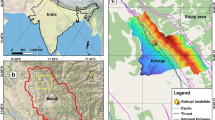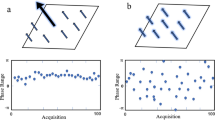Abstract
Starting from the basic equation of landslide movement, a numerical model for landslide movement was presented through the calculus transformation of differential equations and further numerical discretization. Also, some typical analytical examples and real landslides were calculated and analyzed by applying the established numerical model. The results show that the numerical results are in good agreement with the analytical solutions and the actual disasters; therefore, they verify the correctness and effectiveness of the presented numerical models. Compared with existing landslide movement models, the established model has some special characteristics, such as static-dynamic unity, clear physical conception, and simple numerical format, which facilitate the analysis and provide references for disaster forecast.










Similar content being viewed by others
Data availability
Some or all data, models, or code generated or used during the study are proprietary or confidential in nature and may only be provided with restrictions.
References
Albaba A, Schwarz M, Wendeler C, Loup B, Luuk D (2019) Numerical modeling using an elastoplastic-adhesive discrete element code for simulating hillslope debris flows and calibration against field experiments. Nat Hazard 19(11):2339–2358
Bouchut F, Fernandez-Nieto ED, Mangeney A, Lagrée PY (2008) On new erosion models of Savage-Hutter type for avalanches. Acta Mech 199(1–4):181–208
Brown JL (2012) Taming the Missouri: Fort Peck Dam. Civil Eng 82(11):42–45
Casagrande A (1965) Role of the calculated risk in earthwork and foundation engineering. J Soil Mech Found Div Am Soc Civ Eng 91(4):1–40
Chu X, Li L, Yu G, Yuan C (2019) Comparison of slope failure areas between limit equilibrium method and smoothed particle hydrodynamics. Eur J Environ Civ 19:1-7
Denlinger RP, Iverson RM (2004) Granular avalanches across irregular three-dimensional terrain: 1. Theory and computation. J Geophys Res-Earth 109(F1):F01014
Dent JD, Lang TE (1983) A biviscous modified Bingham model of snow avalanche motion. Ann Glaciol 4:42–46
Deuk-hwan L, Lee SR, Joon-Young P (2019) Numerical simulation of debris flow behavior at Mt. Umyeon using the DAN3D model. J Korean Soc Hazard Mitig 19(3):195–202
Dong YK, Grabe J (2018) Large scale parallelisation of the material point method with multiple GPUs. Comput Geotech 101:149–158
Fan YY, Wu FY, Li M, Liang L (2019) Research on the entrainment of path material by the granular flow. KSCE J Civ Eng 23(12):5051–5063
Fei JB, Chen TL, Jie YX, Zhang BY, Fu XD (2016) Three-dimensional yield-criterion-based flow model for avalanches. Mech Res Commun 73:25–30
Gan JJ, Zhang YX (2019) Numerical simulation of debris flow runout using Ramms: a case study of Luzhuang Gully in China. CMES-Comp Model Eng 121(3):981–1009
Gao Y, Li B, Gao HY, Chen LC, Wang YF (2020) Dynamic characteristics of high-elevation and long-runout landslides in the Emeishan basalt area: a case study of the Shuicheng “7.23” landslide in Guizhou, China. Landslides 7(17):1680–1679
Han XD, Chen JP, Xu PH, Niu CC, Zhan JW (2018) Runout analysis of a potential debris flow in the Dongwopu gully based on a well-balanced numerical model over complex topography. Bull Eng Geol Env 77(2):679–689
Hungr O, Evans SG (2004) Entrainment of debris in rock avalanches; an analysis of a long run-out mechanism. Geol Soc Am Bull 116(9–10):1240–1252
Hungr O, McDougall S (2009) Two numerical models for landslide dynamic analysis. Comput Geosci 35(5):978–992
Hutter K, Siegel M, Savage SB, Nohguchi Y (1993) Two-dimensional spreading of a granular avalanche down an inclined plane: 1 Theory. Acta Mech 100(1):37–68
Iverson RM, Denlinger RP (2001) Flow of variably fluidized granular masses across three-dimensional terrain: 1 Coulomb mixture theory. J Geophys Res-Sol Earth 106(B1):537–552
Iverson RM, Ouyang C (2015) Entrainment of bed material by Earth-surface mass flows: review and reformulation of depthintegrated theory. Rev Geophys 53(2):27–58
Juez C, Murillo J, Garcia-Navarro P (2013) 2D simulation of granular flow over irregular steep slopes using global and local coordinates. J Comput Phys 255:166–204
Jun BH (2016) Numerical simulation of the topographical change in Korea mountain area by intense rainfalland consequential debris flow. Adv Meteorol 2016:9363675
Li B, Xing AG, Xu C (2017) Simulation of a long-runout rock avalanche triggered by the Lushan earthquake in the TangjiaValley, Tianquan, Sichuan, China. Eng Geol 218:107–116
Li P, Hu K, Wang X (2018) Debris flow entrainment rates in non-uniform channels with convex and concave slopes. J Hydraul Res 56(2):156–167
Li SM, Yuan LW, Yang H, An HM, Wang GJ (2020) Tailings dam safety monitoring and early warning based on spatial evolution process of mud-sand flow. Safety Sci 124:104579
Liu B, Hu XW, Ma GT, He K, Wu MY, Liu DY (2021) Back calculation and hazard prediction of a debris flow in Wenchuan meizoseismal area, China. Bull Eng Geol Env 80(4):3457–3474
Liu KF, Mei CC (1989) Slow spreading of a sheet of Bingham fluid on an inclined plane. J Fluid Mech 207:505–529
Liu W, Yang ZJ, He SM (2020) Modeling the landslide-generated debris flow from formation to propagation and run-out by considering the effect of vegetation. Landslides 18(1):43–58
Luna BQ, Blahut J, Camera C, van Westen C, Apuani T, Jetten V, Sterlacchini S (2014) Physically based dynamic run-out modelling for quantitative debris flow risk assessment: a case study in Tresenda, northern Italy. Environ Earth Sci 72(3):645–661
Mangeney A, Heinrich P, Roche R (2000) Analytical solution for testing debris avalanche numerical models. Pure Appl Geophys 157(6):1081–1096
McDougall S, Hungr O (2005) Dynamic modelling of entrainment in rapid landslides. Can Geotech J 42(5):1437–1448
Middlebrooks TA (1942) Fort Peck Slide. Trans Am Soc Civ Eng 107(1):723–742
Ouyang CJ, He SM, Tang C (2015) Numerical analysis of dynamics of debris flow over erodible beds in Wenchuan earthquake-induced area. Eng Geol 194(SI):62–72
Pasculli A, Cinosi J, Turconi L, Sciarra N (2021) Learning case study of a shallow-water model to assess an early-warning system for fast Alpine muddy-debris-flow. Water 13(6):750
Pirulli M, Mangeney A (2008) Results of back-analysis of the propagation of rock avalanches as a function of the assumed rheology. Rock Mech Rock Eng 41(1):59–84
Savage SB, Hutter K (1991) The dynamics of avalanches of granular materials from initiation to runout. I: analysis. Acta Mech 86(1–4):201–223
Segura-Beltrána F, Sanchis-Ibor C, Morales-Hernándezc M, González-Sanchisd M, Bussie G, Ortizf E (2016) Using post-flood surveys and geomorphologic mapping to evaluate hydrological and hydraulic models: the flash flood of the Girona River (Spain) in 2007. J Hydrol 541(SI):310–329
Shi BT, Zhang Y, Zhang W (2019) Run-out of the 2015 Shenzhen landslide using the material point method with the softening model. Bull Eng Geol Env 78(2):1225–1236
Stamatopoulos CA (2015) Constitutive and multi-block modeling of slides on saturated sands along slip surfaces. Soils Found 55(4):703–719
Takahashi T (2007) Debris flow mechanics, prediction and countermeasures. Taylor & Francis, London
Voight B, Sousa J (1994) Lessons from Ontake-san: a comparative analysis of debris avalanche dynamics. Eng Geol 38(3–4):261–297
Wang LZ, Jiang HY, Yang ZX, Xu YC, Zhu XB (2013) Development of discontinuous deformation analysis with displacement-dependent interface shear strength. Comput Geotech 47:91–101
Yao X, Yu K, Zhang YS, Li LJ, Zhou NJ (2014) Mechanisms of catastrophic landslide on January 11, 2013, in Zhenxiong county:fluidization initiation and movement liquefaction of high porosity soil. Chin J Rock Mech Eng 33(5):1047–1054 [In Chinese]
Yin YP, Xing AG, Wang GH, Feng Z, Li B, Jiang Y (2017) Experimental and numerical investigations of a catastrophic long-runout landslide in Zhenxiong, Yunnan, southwestern China. Landslides 14(2):649–659
Yu B, Dalbey K, Webb A, Bursik M, Patra A, Pitman EB, Nichita C (2009) Numerical issues in computing inundation areas over natural terrains using Savage-Hutter theory. Nat Hazards 50(2):249–267
Zhou JW, Cui P, Fang H (2013) Dynamic process analysis for the formation of Yangjiagou landslide-dammed lake triggered by the Wenchuan earthquake. China Landslides 10(3):331–342
Zhu CQ, Huang Y, Zhan LT (2018) SPH-based simulation of flow process of a landslide at hongao landfill in China. Nat Hazard 93(3):1113–1126
Funding
This work is supported by the National Key Research and Development Program of China (Grant No. 2016YFC0801603, 2017YFC1503101), the National Natural Science Foundation of China (Grant No. 41201007), the Fundamental Research Funds for the Central Universities of China (Grant No. N170108029), the Key Science and Technology Projects of Liaoning Province, China (Grant No. 2019JH2-10100035), and the Research Fund for General Science Project of Department of Education of Liaoning Province (Grant No. L2013103). National Key Research and Development Program of China,2016YFC0801603,Yunyun Fan,2017YFC1503101,Yunyun Fan,National Natural Science Foundation of China,41201007,Yunyun Fan,Fundamental Research Funds for Central Universities of the Central South University (CN),N170108029,Yunyun Fan,Key Science and Technology Projects of Liaoning Province,China,2019JH2-10100035,Yunyun Fan,Research Fund for General Science Project of Department of Education of Liaoning Province,L2013103,Yunyun Fan
Author information
Authors and Affiliations
Corresponding author
Rights and permissions
About this article
Cite this article
Fan, Y., Wu, F. A numerical model for landslide movement. Bull Eng Geol Environ 81, 105 (2022). https://doi.org/10.1007/s10064-021-02517-7
Received:
Accepted:
Published:
DOI: https://doi.org/10.1007/s10064-021-02517-7




